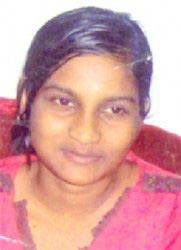Sentenced to 83 years in prison for the murder of his wife, Michael Persaud has appealed his sentence, arguing among other things that Justice Navindra Singh who conducted his trial, committed a number of errors which has resulted in a miscarriage of justice.
And as raised against this judge in several other appeals in recent weeks, Persaud, through his attorney, is also arguing that the sentence imposed by Justice Singh is not only severe, but is without legal basis and does not follow established sentencing guidelines.
Like appellants in other cases, Persaud is complaining that the mathematical formula used by Justice Singh in arriving at his sentences is not only inconsistent with current sentencing practices, but that the judge failed to adequately mitigate his sentence.

As he normally does for persons convicted by a jury of murder before him, Justice Singh commenced Persaud’s sentence at a base of 60 years. And as usual, thereafter, he makes additions based on the nature of any aggravating factors—and deductions for mitigating factors.
In Persaud’s case, highlighting aggravating circumstances, Justice Singh, to the 60-year base; added 10 years for premeditation, 10 years for cruelty and the manner in which the deceased died and an additional 6 years for domestic violence.
From the accumulated 86 years, he then deducted three years for the time Persaud would have spent on remand awaiting trial—that being from 2011 to 2014. Persaud was sentenced on November 27th, 2014.
Persaud was convicted by the jury for the December 2011 murder of his 19-year-old wife Maduri Padumdeo, whose nude body was discovered in the bedroom of her 10×10 Lot 8 North Sophia apartment, with a black and white wire wrapped around her neck.
Among the 13 grounds on which he appeals his conviction and sentence, Persaud says that Justice Singh failed to adequately direct the jury on how it needed to assess circumstantial evidence, failure for which he contends has resulted in a “substantial miscarriage of justice” and prejudice to his case.
According to him, he suffered a miscarriage of justice and his case was also prejudiced because the trial judge failed to adequately put his defence to the jury.
Through his attorney Glenn Hanoman, Persaud (the appellant), complains of material irregularities being allowed during his trial, when Justice Singh permitted jurors to leave the courtroom for short periods during the closing address.
Persaud said that one juror in particular was visibly ill “and was vomiting continually and uncontrollably” on the corridors outside of the courtroom, immediately before they were called upon to deliberate.
The appellant advances in his notice of appeal that at 10 minutes past midday on the last day of the trial, after Justice Singh had finished summing up the case, the “visibly ill”
juror and the rest of the 12-member panel “were instructed to deliberate without any allowance for a lunch break.”
Persaud is of the view that the manner in which the jury was constrained to deliberate “was grossly unfair and prejudicial” to him as each juror may not have been able to fully appreciate the coherence of the arguments, due to the “unusual interruptions, discomfort and the medical condition” of the ill juror.
Persaud also complains of situation which he said arose and warranted the judge recusing himself from the case completely, but he did not so do.
The appellant alleged that there was an interaction between Justice Singh’s wife and his (Persaud’s) grandmother during the trial, for which the judge ordered his grandmother to be detained for some five hours.
There were also a material irregularity which Persaud said resulted in a substantial miscarriage of justice in the trial judge permitting persons into the courtroom, wearing prominently displayed large buttons with the face of the deceased—as well as the 5-year-old child of the deceased being present in the court and in open view of the jury during his attorney’s addresses and the judge’s summing up.
This, he said, was also allowed during the announcement of the verdict.
Having been initially unable to retain an attorney of his own choosing for the trial, Persaud said that Justice Singh erred in law when he refused to accede to his request for a sufficiently long adjournment so as to allow him to retain counsel of his choice.
The appellant declared that the judge erred by “personally and unilaterally” appointing and assigning counsel to him, without his consent.
In so doing, Persaud has expressed the view that his right to a fair trial was “irretrievably and adversely affected.” On this point, he complains of having been assigned a lawyer who did not take full instructions from him (Persaud).
He said that the lawyer failed to object among other things, to the admission into evidence of an “incriminating and prejudicial” caution statement which resulted in a miscarriage of justice and prejudice to his case.
The appellant said that Justice Singh himself wrongly decided to admit into evidence, the caution statement attributed to him thereby resulting in a substantial miscarriage of justice for several reasons.
Among those reasons he said, was the fact that the statement was ruled as having been freely and voluntarily given by him (Persaud) in the absence of any evidential basis being laid and without consideration of fairness.
He said that the statement had been wrongly admitted as an exhibit in the trial without clarification as to whether it was being admitted for the truth of its contents and without the trial judge first directing his mind to issues surrounding its admissibility.
Hanoman highlighted in his client’s notice of appeal that the Justice Singh did not allow the statement to be read to the jury, or even refer to its actual contents in his directions to the jury.
Additionally, counsel said that the judge wrongly directed the jury to consider the prosecution’s case that the caution statement, together with other evidence, compelled a conclusion that Persaud was the only person with the deceased when she was killed.
Meanwhile, raising specific issues with the sentencing, Hanoman deposed in his client’s notice of appeal that Justice Singh “utilized a mathematical formula” in passing sentence which is without legal basis, while adding that he failed to take into account established sentencing guidelines.
According to Persaud, the sentence passed “was inconsistent with the current sentencing practice.”
He contends too, that Justice Singh failed to explore the possibility of ordering a probation report as a means of considering other relevant factors, while noting that the attorney assigned to him for the trial failed to adequately mitigate his sentence.
He specifically advances that his sentence was unduly harsh, which he said the judge permitted the prosecution to press for.
With the hearing of the appeal having come to an end, the court has said that notices will be sent informing when a decision will be made in the matter.
The matter is being heard by acting Chancellor Yonette Cummings-Edwards and Justices of Appeal Rishi Persaud and Dawn Gregory, at the Guyana Court of Appeal.
Just last week, Justice Singh’s sentencing policy came under scrutiny before the appellate court when attorney Ronald Burch-Smith, on behalf of appellant Quaison Jones, submitted that the judge’s formula for sentencing was “arbitrary, unfair and unconstitutional.”
In that case, however, Deputy Director of Public Prosecutions, Diana Kaulesar-O’Brien, had vehemently argued that there exists no law which the judge’s sentencing offends.





